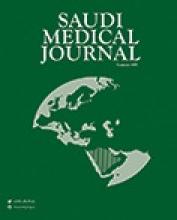Abstract
OBJECTIVE: To study the laboratory diagnosis of tuberculosis (TB), and relate the findings to its epidemiology in Central Saudi Arabia.
METHODS: This retrospective study was carried out at the Department of Pathology/Microbiology, King Khalid University Hospital, Riyadh, Kingdom of Saudi Arabia between January 2003 and December 2010. Data were retrieved from the hospital information system on laboratory findings. After adjustment, 9,405 specimens were studied. The specimens were stained by Ziehl-Neelsen (ZN), auramine-rhodamine, and cultured in Bactec alert 960, and Lowenstein-Jensen media. Mycobacterium tuberculosis (M. tuberculosis) complex and non-tuberculous mycobacteria were differentiated by ProbTec system and p-nitrobenzoate medium. The BACTEC MGIT 960 SIRE kit was used for susceptibility testing.
RESULTS: A total of 568 (6%) specimens grew M. tuberculosis complex, and 87% were from Saudis with an incidence rate of 55.6/100,000 of TB. Time to positive growth in the Bactec liquid medium was directly related to the acid fast bacilli smear load. Most of the positive patients were from the 18-35 years age group. The percentage of multidrug resistance was 0.7%.
CONCLUSION: Most patients (87%) were Saudis showing an incident rate of 55.6/100,000. An increase of TB cases was noticed in the 18-35 age group. Resistance to isoniazid was 10.6%, 1% to Rifampicin, 2-8% to Ethambutol, and streptomycin was 6%.
- Copyright: © Saudi Medical Journal
This is an open-access article distributed under the terms of the Creative Commons Attribution-Noncommercial-Share Alike 3.0 Unported, which permits unrestricted use, distribution, and reproduction in any medium, provided the original work is properly cited.






